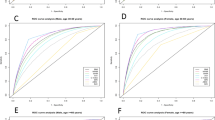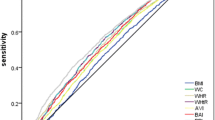Abstract
OBJECTIVE: Obesity is a major public health problem due to its associations with multiple cardiovascular risk factors. Although there are sophisticated methods, such as imaging, to document total body fat and its distributions, anthropometric measurements remain important in clinical practice. We examined the relationships between cardiovascular risk factors and the three commonest anthropometric measurements for obesity, body mass index (BMI), waist–hip ratio (WHR) and waist circumference (WC), in Hong Kong Chinese subjects. DESIGN AND SETTING: The data are obtained from a prevalence survey for glucose intolerance and lipid abnormality in a representative Hong Kong Chinese working population. All employees from a public utility company and a regional hospital were invited to participate. SUBJECTS: There were 1513 subjects (910 men and 603 women, mean age ± s.e.m.: 37.5±0.2 y). All of them had no significant past medical history. MEASUREMENTS: BMI, WHR and WC of the 1513 subjects were assessed for their relationships with various cardiovascular risk factors. These include blood pressure, fasting and 2 h plasma glucose and insulin, glycated haemoglobin, total cholesterol, triglyceride, high density and low density lipoprotein cholesterol, and urine albumin concentration. RESULTS: After age adjustment, all three anthropometric indexes were significantly correlated with the major cardiovascular risk factors in both men and women. When BMI, WHR and WC were analysed according to quartiles, there was a significant trend for blood pressure, plasma triglyceride, fasting and 2 h plasma glucose and insulin to increase, and high density lipoprotein cholesterol to decrease, with increasing obesity after adjustment for age and smoking. Using stepwise regression analysis with the three indexes as independent variables, most of the variance in blood pressure, plasma lipid, insulin, glucose and urinary albumin concentration were explained either by WC or WHR. In women, BMI was the main explanatory variable for reduced high density lipoprotein cholesterol. CONCLUSIONS: In Hong Kong Chinese, BMI, WHR and WC provide important information in assessing cardiovascular risks. In men, central adiposity as reflected by WC and to some extent, WHR, explained most of the variance in blood pressure, plasma glucose, lipid, insulin and albuminuria. In women, all three indexes reflecting general and central obesity contribute to the variance in these risk factors.
Similar content being viewed by others
Author information
Authors and Affiliations
Rights and permissions
About this article
Cite this article
Ko, G., Chan, J., Woo, J. et al. Simple anthropometric indexes and cardiovascular risk factors in Chinese. Int J Obes 21, 995–1001 (1997). https://doi.org/10.1038/sj.ijo.0800508
Received:
Revised:
Accepted:
Issue Date:
DOI: https://doi.org/10.1038/sj.ijo.0800508
- Springer Nature Limited
Keywords
This article is cited by
-
Sagittal abdominal diameter and its socioeconomic correlates: perspective of sex differences
BMC Public Health (2021)
-
Epidemiology of Diabetes Mellitus and Cardiovascular Disease
Current Cardiology Reports (2019)
-
The product of fasting plasma glucose and triglycerides improves risk prediction of type 2 diabetes in middle-aged Koreans
BMC Endocrine Disorders (2018)
-
Waist-to-height ratio index for predicting incidences of hypertension: the ARIRANG study
BMC Public Health (2018)
-
Anthropometric indices as predictors of hypertension among men and women aged 40–69 years in the Korean population: the Korean Genome and Epidemiology Study
BMC Public Health (2015)




